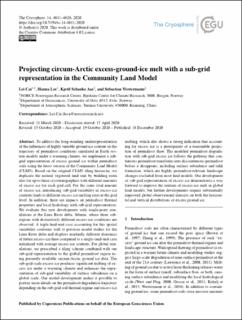| dc.contributor.author | Cai, Lei | |
| dc.contributor.author | Lee, Hanna | |
| dc.contributor.author | Aas, Kjetil Schanke | |
| dc.contributor.author | Westermann, Sebastian | |
| dc.date.accessioned | 2021-01-28T12:21:09Z | |
| dc.date.available | 2021-01-28T12:21:09Z | |
| dc.date.created | 2020-12-21T21:27:03Z | |
| dc.date.issued | 2020 | |
| dc.identifier.citation | The Cryosphere. 2020, 14 4611-4626. | en_US |
| dc.identifier.issn | 1994-0416 | |
| dc.identifier.uri | https://hdl.handle.net/11250/2725189 | |
| dc.description.abstract | To address the long-standing underrepresentation of the influences of highly variable ground ice content on the trajectory of permafrost conditions simulated in Earth system models under a warming climate, we implement a sub-grid representation of excess ground ice within permafrost soils using the latest version of the Community Land Model (CLM5). Based on the original CLM5 tiling hierarchy, we duplicate the natural vegetated land unit by building extra tiles for up to three cryostratigraphies with different amounts of excess ice for each grid cell. For the same total amount of excess ice, introducing sub-grid variability in excess-ice contents leads to different excess-ice melting rates at the grid level. In addition, there are impacts on permafrost thermal properties and local hydrology with sub-grid representation. We evaluate this new development with single-point simulations at the Lena River delta, Siberia, where three sub-regions with distinctively different excess-ice conditions are observed. A triple-land-unit case accounting for this spatial variability conforms well to previous model studies for the Lena River delta and displays markedly different dynamics of future excess-ice thaw compared to a single-land-unit case initialized with average excess-ice contents. For global simulations, we prescribed a tiling scheme combined with our sub-grid representation to the global permafrost region using presently available circum-Arctic ground ice data. The sub-grid-scale excess ice produces significant melting of excess ice under a warming climate and enhances the representation of sub-grid variability of surface subsidence on a global scale. Our model development makes it possible to portray more details on the permafrost degradation trajectory depending on the sub-grid soil thermal regime and excess-ice melting, which also shows a strong indication that accounting for excess ice is a prerequisite of a reasonable projection of permafrost thaw. The modeled permafrost degradation with sub-grid excess ice follows the pathway that continuous permafrost transforms into discontinuous permafrost before it disappears, including surface subsidence and talik formation, which are highly permafrost-relevant landscape changes excluded from most land models. Our development of sub-grid representation of excess ice demonstrates a way forward to improve the realism of excess-ice melt in global land models, but further developments require substantially improved global observational datasets on both the horizontal and vertical distributions of excess ground ice. | |
| dc.language.iso | eng | en_US |
| dc.rights | Navngivelse 4.0 Internasjonal | * |
| dc.rights.uri | http://creativecommons.org/licenses/by/4.0/deed.no | * |
| dc.subject | Permafrost | |
| dc.subject | Permafrost | |
| dc.title | Projecting circum-Arctic excess-ground-ice melt with a sub-grid representation in the Community Land Model | en_US |
| dc.type | Journal article | en_US |
| dc.type | Peer reviewed | en_US |
| dc.rights.holder | © 2020, Authors | |
| dc.description.version | publishedVersion | |
| cristin.ispublished | true | |
| cristin.fulltext | original | |
| cristin.qualitycode | 2 | |
| dc.identifier.doi | 10.5194/tc-14-4611-2020 | |
| dc.identifier.cristin | 1862518 | |
| dc.source.journal | The Cryosphere | en_US |
| dc.source.volume | 14 | en_US |
| dc.source.pagenumber | 4611-4626 | en_US |
| dc.relation.project | Norges forskningsråd: 270061 | |
| dc.relation.project | Norges forskningsråd: 294948 | |
| dc.relation.project | Norges forskningsråd: 255331 | |

